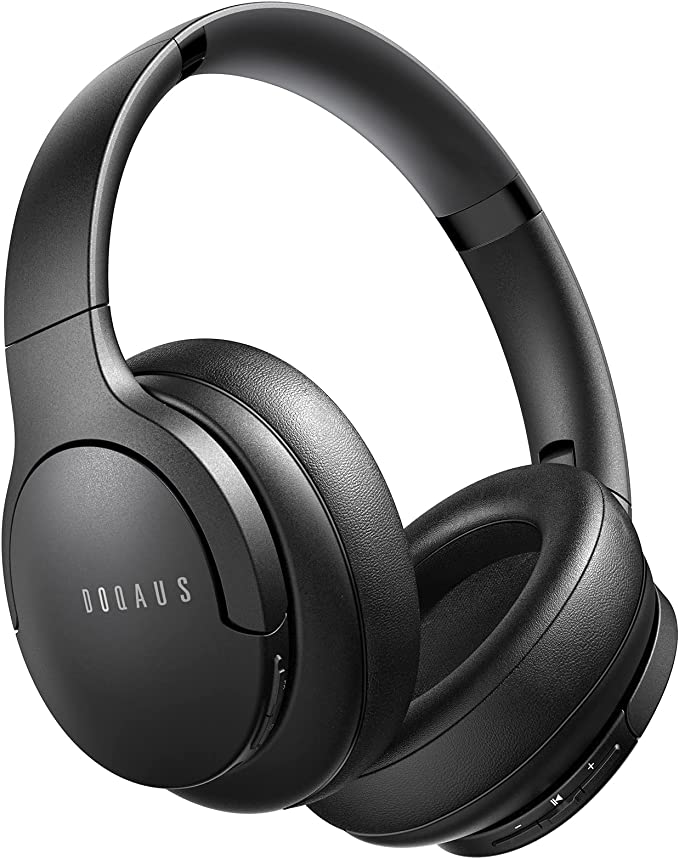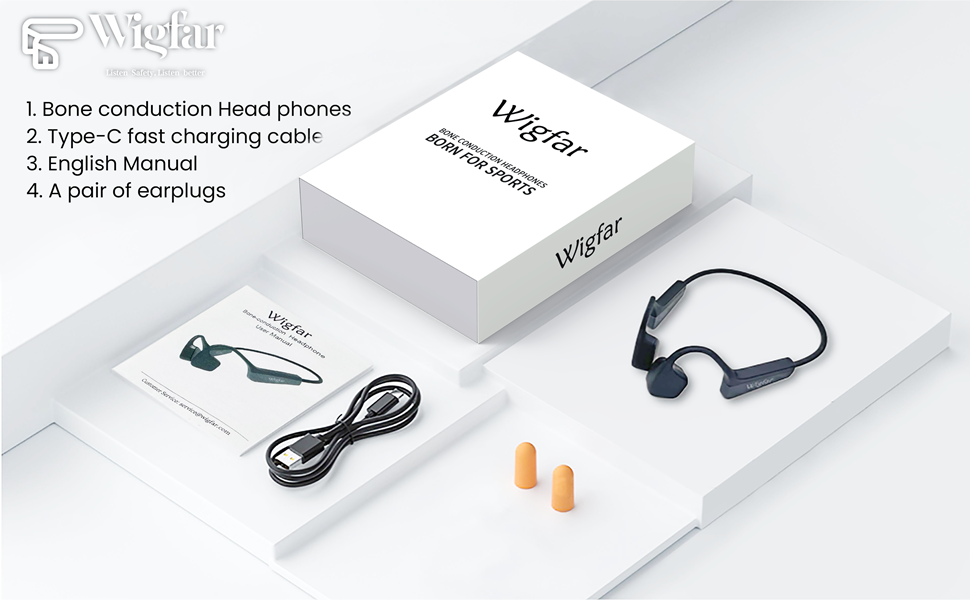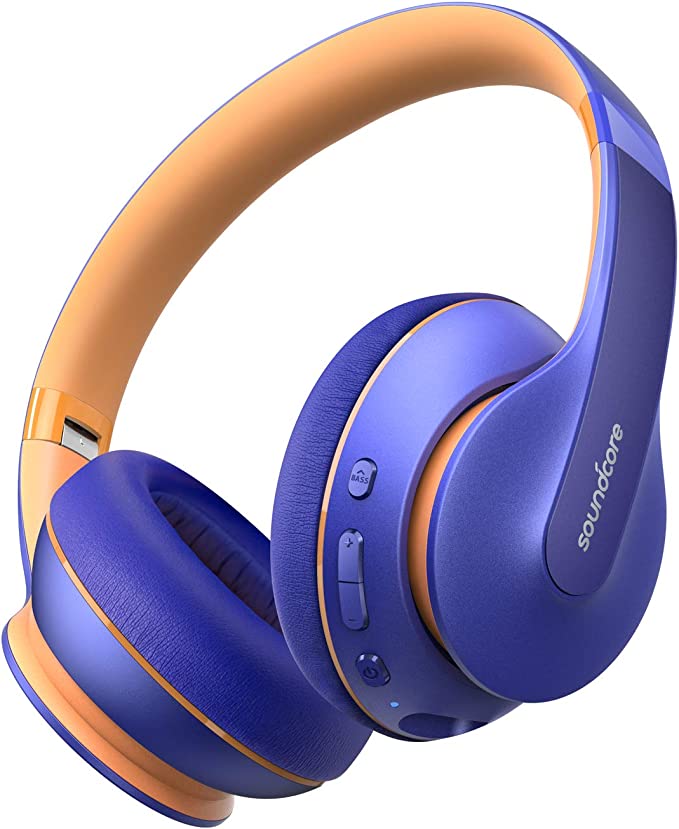Wireless headphones have become almost an extension of ourselves. We grab them for commutes, workouts, focus sessions, or just escaping into our favorite music. The market is flooded with options, often boasting impressive-sounding specifications: “90-Hour Playtime!”, “Bluetooth 5.3!”, “Deep Bass!”. These features sound great on paper, but what do they actually mean for your listening experience? How does that technology truly work?
It’s easy to feel overwhelmed by the jargon. Instead of just taking the specs at face value, let’s pull back the curtain. We’ll use a specific, accessible example – the DOQAUS LIFE 4 Bluetooth Headphones – not as a sales pitch, but as a lens through which we can explore the fascinating science and engineering packed into modern audio gear. Let’s demystify the numbers and acronyms, and understand how invisible signals, tiny vibrating components, clever power management, and material science come together to deliver sound to your ears.

The Invisible Leash: Making Sense of Bluetooth 5.3
At the heart of any wireless headphone is Bluetooth, that ubiquitous standard for short-range radio communication. The LIFE 4 headphones feature Bluetooth 5.3. You might see different version numbers touted, but what does “5.3” signify in practical terms?
Think of Bluetooth evolution like upgrading a city’s highway system. Each new version aims to improve traffic flow, reduce congestion, and enhance efficiency. Bluetooth 5.3 builds upon the foundations of the 5.x series, focusing particularly on refinements that benefit devices like headphones.
One key area is connection stability and efficiency. The product description mentions a potential range of up to 66 feet (20 meters). While this is an ideal-condition figure (walls and interference from other devices like microwaves or even other Bluetooth gadgets will reduce this in the real world), Bluetooth 5.3 incorporates protocol improvements designed to make the connection more robust. It’s smarter about navigating the crowded 2.4GHz radio frequency band, aiming to minimize those annoying audio dropouts or stutters. It’s like having a more intelligent traffic management system for the radio waves connecting your phone to your headphones.
Perhaps more critically for portable devices, Bluetooth 5.3 continues the focus on energy efficiency. It builds on the Bluetooth Low Energy (LE) foundation, meaning the headphones’ radio can maintain a stable connection while consuming minimal power. This isn’t just a minor tweak; it’s a fundamental reason why impressive battery life figures, like the one claimed for the LIFE 4, are even possible. We’ll dive deeper into this in the battery section, but remember: an efficient wireless connection is step one to marathon listening sessions.
Bluetooth 5.3 also offers potential improvements in latency – the tiny delay between the source device sending the audio and the headphones playing it. While the actual latency depends on various factors including the paired device and audio codecs used, protocol enhancements in 5.3 aim to reduce this delay, which is particularly noticeable and important when watching videos or playing games, ensuring the audio syncs properly with the visuals.
So, when you see “Bluetooth 5.3,” think of it as the underlying communication system striving for a more reliable, longer-lasting, and potentially more responsive wireless link – the invisible, yet crucial, tether for your audio.

Crafting Your Soundscape: Drivers, Fidelity, and That Bass Drop
How do headphones actually make sound? Inside each earcup of the DOQAUS LIFE 4 reside 40mm stereo drivers. These are the workhorses, the tiny engines converting electrical audio signals back into the sound waves your ears can perceive. A driver typically consists of a diaphragm (a thin cone or dome), a voice coil attached to it, and a magnet. When the audio signal flows through the voice coil within the magnetic field, it causes the coil and the attached diaphragm to rapidly vibrate back and forth, pushing air and creating sound waves.
The 40mm driver size is common for over-ear headphones. Generally speaking, a larger diaphragm surface area has the potential to move more air than a smaller one. This can be advantageous for reproducing lower frequencies – the bass and sub-bass that give music weight and impact. Think of it like the displacement of an engine; a larger engine has the potential for more power, though how that power is used depends on the overall design.
The LIFE 4 is described as offering HiFi Stereo Sound and Deep Bass. “Stereo” is straightforward: two distinct channels (left and right) create a sense of space and directionality. “HiFi,” or High Fidelity, is more of an aspirational term, especially in budget-friendly gear. It represents the goal of reproducing sound as accurately and faithfully as possible to the original recording, with minimal distortion or coloration. Achieving true HiFi depends on numerous factors: the quality of the drivers, the design of the headphone enclosure, the source audio file, the amplification, and even the Bluetooth audio codec used (which isn’t specified here, likely the standard SBC).
“Deep Bass” is often achieved through a combination of driver capability and acoustic tuning. The 40mm drivers provide the physical foundation, but the headphone’s enclosure design and deliberate tuning (how the manufacturer shapes the frequency response) play a huge role in emphasizing those lower frequencies. It’s worth noting that based on the provided user feedback, many users seem to appreciate the bass performance of the LIFE 4, suggesting a tuning choice geared towards a warmer, bass-forward sound signature – a popular preference. However, this emphasis can sometimes come at the cost of clarity in other frequency ranges, as one user noted potential harshness in female vocals. Sound perception is inherently subjective; what one person calls “deep bass,” another might call “boomy.”
Ultimately, the drivers are the starting point, but the final sound is a complex interplay of physics, engineering choices, and your own ears.

Your Sound, Your Rules: The EQ Mode Playground
Even with a specific tuning, wouldn’t it be great to tweak the sound to your liking? That’s where Equalization (EQ) Modes come in. Think of EQ as a simple set of controls for adjusting the “flavor profile” of your audio – turning up the bass, bringing out the vocals in the midrange, or adding sparkle to the treble.
The DOQAUS LIFE 4 offers three preset EQ modes, selectable via a button: reportedly “Well-balanced,” “Bass boosted,” and “High definition.”
* Well-balanced: Likely aims for a more neutral, even response across frequencies, suitable for various genres or spoken word content like podcasts.
* Bass boosted: As the name suggests, this mode increases the volume of the lower frequencies, ideal for electronic music, hip-hop, or action movies where you want that extra rumble.
* High definition: This mode might slightly boost the higher frequencies (treble) to enhance perceived clarity, detail, and brightness, perhaps beneficial for acoustic music or certain vocal tracks.
These presets offer a convenient way to quickly tailor the sound without needing a complex app or manual EQ adjustments. Listening to a podcast? Balanced mode might be best. Switching to some EDM? A tap brings on the Bass Boost. It’s like having a simple sound “调色板” (tiao sè bǎn – color palette) at your fingertips.
This convenience is a definite plus. However, it’s important to note an objective piece of feedback reported by a user in the provided materials: on their unit, the selected EQ mode wasn’t saved when the headphones were turned off and on again, reverting to the default (likely “Balanced”). While this might be an isolated issue or a specific design choice to ensure a consistent starting point, it highlights a potential minor usability quirk for those who prefer a specific sound profile consistently. Regardless, the presence of EQ modes themselves adds a valuable layer of personalization to the listening experience.
The Powerhouse Paradox: Achieving 90-Hour Stamina
Perhaps the most eye-catching specification is the claimed up to 90 hours of playtime in Bluetooth mode. In a world where we’re constantly hunting for chargers, that figure sounds almost unbelievable for affordable headphones. How do they pull it off? It’s not magic, but a combination of two key ingredients: a decent fuel tank and remarkable fuel efficiency.
Ingredient 1: The Fuel Tank. The LIFE 4 houses Lithium Polymer (Li-Po) batteries, a common choice for modern portable electronics. The product description mentions a 1000mAh (milliampere-hour) capacity. Think of mAh as a measure of the battery’s electrical charge capacity – essentially, how much “fuel” it can hold. 1000mAh is a respectable capacity for headphones. Li-Po batteries are favored for their relatively high energy density (packing more power into a smaller, lighter package) and flexible form factors compared to older battery chemistries.
Ingredient 2: Sipping, Not Gulping. Capacity alone doesn’t guarantee long life; efficiency is paramount. This is where Bluetooth 5.3’s Low Energy focus becomes absolutely critical. The radio chip is designed to perform its communication duties while drawing minimal power. Alongside the Bluetooth chip, modern System-on-a-Chip (SoC) designs used in wireless headphones integrate audio processing and power management functions very efficiently. They’re like a marathon runner with an incredibly efficient stride – they can go the distance without burning through their energy reserves quickly.
Combined, a reasonably large battery and highly efficient components make the 90-hour claim plausible under specific conditions (like listening at moderate volume levels). What does this mean for you? Potentially weeks of typical daily use (e.g., an hour or two a day) on a single charge. It means less charging anxiety, more freedom, and reliability for long trips or extended listening sessions.
And what if the battery finally runs out at an inconvenient moment? The LIFE 4 includes a standard 3.5mm audio cable, allowing you to plug into devices the old-fashioned way. In wired mode, the headphones operate passively, drawing power directly from the source device – no battery needed. It’s a reliable backup plan. When you do need to recharge, the specified charging time is 2.5 hours via the included USB cable. Interestingly, one user review mentioned the ability to charge the headphones while listening via Bluetooth, a convenient feature not always found on wireless headphones.

The Fit Factor: Comfort, Design, and the Reality of Ears
All the technology in the world doesn’t matter if the headphones are uncomfortable to wear. The DOQAUS LIFE 4 utilizes an over-ear design, meaning the earcups are intended to completely surround your ears, resting on the sides of your head rather than directly on the ear cartilage (like on-ear models). This approach has two potential benefits: it helps distribute the clamping force of the headband more evenly, potentially increasing comfort during long listening sessions, and it creates a physical seal around the ear, which aids in passive noise isolation – physically blocking out some ambient sound without needing complex electronics like Active Noise Cancellation (ANC).
Enhancing this comfort is the use of memory-protein earmuffs. The star here is memory foam, a type of viscoelastic polyurethane foam. “Viscoelastic” means it exhibits both viscous (fluid-like flow) and elastic (springy) properties. When you put the headphones on, your body heat softens the foam slightly, allowing it to conform precisely to the unique contours around your ears. This custom molding helps distribute pressure evenly, reducing potential pressure points and soreness. When you take them off, the foam slowly returns to its original shape. Think of it as a custom-fit cushion for your ears.
However, comfort and fit are intensely personal. While the design aims for comfort with the over-ear style and memory foam, the provided user feedback reveals a critical point: fit is highly subjective and depends heavily on individual head and ear size/shape. One detailed review specifically noted that for their “average-sized adult male ears” (measured at ~71mm top-to-bottom), the earcup openings (~64mm height) were too small, causing the cups to sit on the ears rather than fully around them. This user also reported discomfort when wearing glasses and found the clamping force slightly tight. Conversely, other users reported finding the headphones comfortable for hours.
This discrepancy doesn’t necessarily mean the headphones are poorly designed, but rather highlights the challenge of creating a “one-size-fits-all” ergonomic solution. What feels snug and secure to one person might feel tight or ill-fitting to another. The effectiveness of the seal, crucial for both bass response and passive noise isolation, also relies heavily on achieving a good fit. Therefore, while the materials and design principles aim for comfort, potential buyers should be aware that individual results may vary significantly – a common reality with any headphone purchase.
Beyond the fit, practical touches include an adjustable soft headband to accommodate different head sizes and a foldable design, making the headphones more compact for storage or travel.

Finishing Touches: Calls and Cables
While primarily for listening, the LIFE 4 includes a built-in HD microphone. This allows you to take phone calls wirelessly when connected to your phone via Bluetooth, adding a layer of hands-free convenience. The “HD” likely refers to the potential support for wideband audio codecs during calls (if supported by the network and paired phone), aiming for clearer voice quality than traditional narrowband calls.
The package also includes the necessary accessories: the USB charging cable and the aforementioned 3.5mm audio cable for wired listening.
Conclusion: More Than Meets the Eye (or Ear)
So, the next time you glance at the specifications of a pair of headphones like the DOQAUS LIFE 4, look beyond the numbers and buzzwords. That seamless Bluetooth 5.3 connection relies on sophisticated radio protocols striving for stability and efficiency. The sound pulsing from the 40mm drivers is shaped not just by their size but by intricate acoustic tuning, further customizable by EQ modes. The remarkable 90-hour battery life is a testament to the synergy between battery capacity and low-power component design. And the quest for comfort involves material science like memory foam wrestling with the inherent challenges of human anatomical diversity.
The DOQAUS LIFE 4, like many modern electronic devices, represents a convergence of multiple scientific and engineering disciplines, all working together to deliver a specific user experience – in this case, accessible, long-lasting, personalized wireless audio. Understanding the technology inside doesn’t just satisfy curiosity; it empowers us to make more informed choices and appreciate the complex innovation packed into the gadgets we use every day, technology that ultimately serves the simple, universal pleasure of getting lost in sound.




